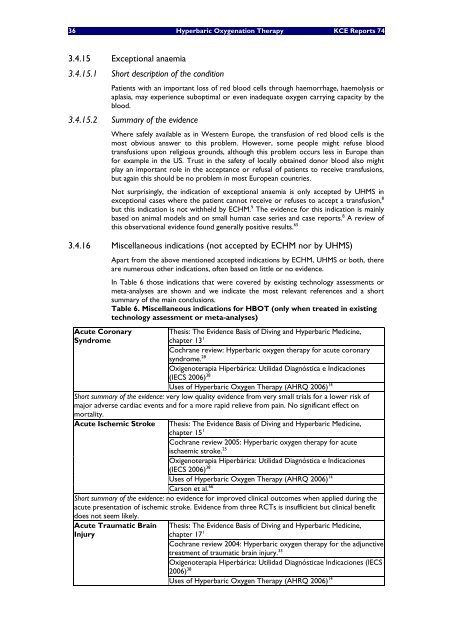Hyperbare Zuurstoftherapie: Rapid Assessment - KCE
Hyperbare Zuurstoftherapie: Rapid Assessment - KCE
Hyperbare Zuurstoftherapie: Rapid Assessment - KCE
You also want an ePaper? Increase the reach of your titles
YUMPU automatically turns print PDFs into web optimized ePapers that Google loves.
36 Hyperbaric Oxygenation Therapy <strong>KCE</strong> Reports 74<br />
3.4.15 Exceptional anaemia<br />
3.4.15.1 Short description of the condition<br />
Patients with an important loss of red blood cells through haemorrhage, haemolysis or<br />
aplasia, may experience suboptimal or even inadequate oxygen carrying capacity by the<br />
blood.<br />
3.4.15.2 Summary of the evidence<br />
Where safely available as in Western Europe, the transfusion of red blood cells is the<br />
most obvious answer to this problem. However, some people might refuse blood<br />
transfusions upon religious grounds, although this problem occurs less in Europe than<br />
for example in the US. Trust in the safety of locally obtained donor blood also might<br />
play an important role in the acceptance or refusal of patients to receive transfusions,<br />
but again this should be no problem in most European countries.<br />
Not surprisingly, the indication of exceptional anaemia is only accepted by UHMS in<br />
exceptional cases where the patient cannot receive or refuses to accept a transfusion, 8<br />
but this indication is not withheld by ECHM. 9 The evidence for this indication is mainly<br />
based on animal models and on small human case series and case reports. 8 A review of<br />
this observational evidence found generally positive results. 65<br />
3.4.16 Miscellaneous indications (not accepted by ECHM nor by UHMS)<br />
Acute Coronary<br />
Syndrome<br />
Apart from the above mentioned accepted indications by ECHM, UHMS or both, there<br />
are numerous other indications, often based on little or no evidence.<br />
In Table 6 those indications that were covered by existing technology assessments or<br />
meta-analyses are shown and we indicate the most relevant references and a short<br />
summary of the main conclusions.<br />
Table 6. Miscellaneous indications for HBOT (only when treated in existing<br />
technology assessment or meta-analyses)<br />
Thesis: The Evidence Basis of Diving and Hyperbaric Medicine,<br />
chapter 13 1<br />
Cochrane review: Hyperbaric oxygen therapy for acute coronary<br />
syndrome. 28<br />
Oxigenoterapia Hiperbárica: Utilidad Diagnóstica e Indicaciones<br />
(IECS 2006) 38<br />
Uses of Hyperbaric Oxygen Therapy (AHRQ 2006) 14<br />
Short summary of the evidence: very low quality evidence from very small trials for a lower risk of<br />
major adverse cardiac events and for a more rapid relieve from pain. No significant effect on<br />
mortality.<br />
Thesis: The Evidence Basis of Diving and Hyperbaric Medicine,<br />
chapter 15 1<br />
Cochrane review 2005: Hyperbaric oxygen therapy for acute<br />
ischaemic stroke. 25<br />
Oxigenoterapia Hiperbárica: Utilidad Diagnóstica e Indicaciones<br />
(IECS 2006) 38<br />
Uses of Hyperbaric Oxygen Therapy (AHRQ 2006) 14<br />
Acute Ischemic Stroke<br />
Carson et al. 66<br />
Short summary of the evidence: no evidence for improved clinical outcomes when applied during the<br />
acute presentation of ischemic stroke. Evidence from three RCTs is insufficient but clinical benefit<br />
does not seem likely.<br />
Acute Traumatic Brain<br />
Injury<br />
Thesis: The Evidence Basis of Diving and Hyperbaric Medicine,<br />
chapter 17 1<br />
Cochrane review 2004: Hyperbaric oxygen therapy for the adjunctive<br />
treatment of traumatic brain injury. 33<br />
Oxigenoterapia Hiperbárica: Utilidad Diagnósticae Indicaciones (IECS<br />
2006) 38<br />
Uses of Hyperbaric Oxygen Therapy (AHRQ 2006) 14

















